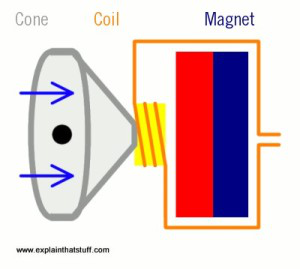The function of permanent magnets in some industrial devices
The function of permanent magnets in some industrial devices
Permanent magnets are those which create their own persistent magnetic field when magnetized by an external magnetic field. The function of permanent magnets in different appliances and instruments is usually one of the following:
- to convert mechanical energy to electrical energy,
- to convert electrical energy to mechanical energy,
- to use the attraction or repulsion between two magnets,
- to control electrons or ions,
Here we will describe the operational functions of permanent magnets in some devices,
- Electric motors:
Electric motors are electrical machines that use electrical energy to produce mechanical energy. Electric motors contain two essential parts, a fixed stator which is usually a permanent magnet and inside the stator there is a rotor which is usually an electromagnetic coil. When applying electricity in the coil, it produces magnetic field which reacts with the magnetic field produced from the permanent magnet stator. This causes the production of mechanical energy in the form of rotating the electromagnetic coil. This mechanical energy is used to move cars, rotate fans, fly drones and so on. For more information about electric motors, please review the blogs for Amit Jha.
A simplified diagram of an electric motor1
- Loudspeakers:
Loudspeaker is another device that converts electrical energy to mechanical energy. The permanent magnet in the loudspeaker is fixed close to a mobile electromagnet coil. The electromagnet is attached to a flexible material called cone (diaphragm). Passing an electric current in the electromagnet causes it to vibrate due to the interaction with the permanent magnet. The cone amplifies these vibrations to produce sound waves. The frequency of vibration controls the pitch of the sound, while the amplitude controls the volume produced. Microphones use the same set as loudspeakers in reverse mechanism to convert sound waves to electrical signal.
A simplified diagram of loudspeaker components2
- Hard disk drives:
Hard disk drives (HDDs) use magnetic storage mechanism in order to write and store information on a magnetic coated disk called platter (the mechanism of reading and writing is fascinating, go and read about it3). Usually there are three permanent magnets in a HDD. A fixed permanent magnet in the actuator, which moves the read-write arm by the interaction with an electromagnet (electricity to mechanical energy), a small magnet at the end of the read-write arm, which is responsible for the reading-writing actions with the platter and a third permanent magnet in the spindle motor to allow the platter to rotate at high speed.
Hard Disk Drive
- Electric generators:
In contrast to electric motors, electric generators convert mechanical energy to electricity. The mechanical energy is driven from winds as in wind turbines, from water as in water turbines, from steam as in steam turbines, from human muscle power, etc.…. An example of electric generator is shown below. The permanent magnet here is fixed surrounding a coil, which is connected to the mechanical energy source causing the latter to rotate. An induced current passes through the coil resulting from the rotation of the coil in the magnetic field from the permanent magnet.
A simplified diagram of an electric generator4
- Maglev:
Maglev is a transportation system that uses magnetic levitation5 to move vehicles. Electrodynamic suspension (EDS) is one type of the Maglev technologies. In EDS both the train and the track exert a magnetic field, and the train is levitated by repulsion and attraction forces between them. The magnetic field of the train is produced by permanent magnets or superconductors, where an induced magnetic field is created in the track to move the train by attraction and repulsion forces.
EDS Maglev6
- Cathode ray tube:
A cathode ray tube (CRT) is a vacuum tube that use electron gun (s) to create images on a phosphorescent screen, by the interaction of electrons beam with the screen. Various magnets are used in the CRT to bend and focus the electron beam. CRT is used in many applications as in oscilloscopes, radar targets and televisions.
Magnets Are Everywhere
Magnets are found in many devices that people use every day. They are in any machine that has a motor. That includes fans, washing machines, and cars. Motors use magnets and coils of wire to turn electrical energy into motion.
Magnets have also helped bring about major advances in health care and transportation. Doctors can diagnose medical conditions through MRI, or magnetic resonance imaging. MRI devices use a magnetic field to create pictures of patients’ organs. In Japan, China, and Germany, high-speed trains use magnets to reach speeds topping 300 miles per hour. The magnets allow the trains to float above the tracks. This gets rid of the friction that would otherwise cause the trains to move at slower speeds. Magnetism is a basic force of nature. It surrounds us. Understanding how magnets work has inspired people to develop groundbreaking and lifesaving technologies.
The function of permanent magnets in different appliances and instruments can be easily manipulated depending on the application in use. This permits them to be used in unlimited number of products as in mobiles, televisions, laundry machines, microwave, cars, synchrotrons, wind turbines and so on. And any simple idea can permit the use of permanent magnets in new set of applications, go and check some videos for mind blowing uses of magnets and magnetism. Some interesting videos for mind blowing uses of magnets and magnetism.

